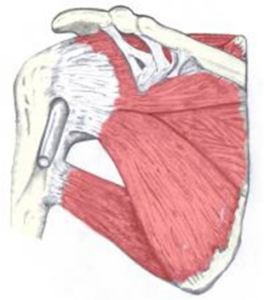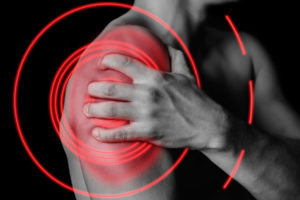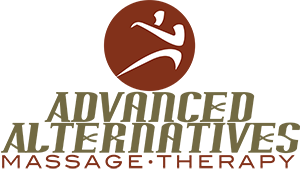Do you have Rotator Cuff or Impingement Syndrome of the shoulder?
 The rotator cuff is a group of four tendons and muscles that converge around the shoulder joint at the top of the humerus, the upper arm bone above the elbow.
The rotator cuff is a group of four tendons and muscles that converge around the shoulder joint at the top of the humerus, the upper arm bone above the elbow.
The rotator cuff muscles include:
- Supraspinatus
- Infraspinatus
- Teres Minor
- Subscapularis
Together, they form a ”cuff” that both holds your arm in place and allows it to move in different directions.
While your shoulder is one of your most mobile joints, it’s also somewhat weak. Too much stress can cause partial tears and swelling in the tendons of the rotator cuff.
Due to the function of these muscles, sports which involve a lot of shoulder rotation – for example, bowling in cricket, pitching in baseball, swimming, kayaking – often put the rotator cuff muscles under a lot of stress. Problems with the rotator cuff muscles can be classed into two categories – Tears of the tendons/muscles, and inflammation of structures in the joint.
Symptoms of Inflammation can be:
- Characteristic ache in the shoulder which feels like it is coming from “deep inside”
- Usually a gradual onset of pain, which “flares up” if using the arms over the head or out to the side
- Can sometimes lead to a chronic conditions if untreated
Symptoms of a rotator cuff tear include:
- Weakness and tenderness in the shoulder
- Sharp persistent pain
- Difficulty moving the shoulder, especially when trying to lift your arm above your head
- Snapping or crackling sounds when moving the shoulder
- Inability to sleep on the shoulder
 Impingement syndrome is a common shoulder condition seen in aging adults. This condition, which is sometimes called Swimmer’s shoulder or Thrower’s Shoulder, is caused by the tendons of the rotator cuff becoming irritated and inflamed as they pass through a narrow bony space called the Sub acromial Space – so called because it is under the arch of the acromion.
Impingement syndrome is a common shoulder condition seen in aging adults. This condition, which is sometimes called Swimmer’s shoulder or Thrower’s Shoulder, is caused by the tendons of the rotator cuff becoming irritated and inflamed as they pass through a narrow bony space called the Sub acromial Space – so called because it is under the arch of the acromion.
This can lead to thickening of the tendon which may cause further problems because there is very little free space, so as the tendons become larger, they are impinged further by the structures of the shoulder joint and the muscles themselves.
When the pressure within the muscle increases, the blood flow is diminished, and the muscle tissue begins to fray much like a rope. Pain is felt by actions such as reaching up behind the back and reaching up overhead. Night pain resulting from this shoulder condition may result in sleep interruption.
Massage Therapy Can Help!
Massage Therapy
Sports Massage and Injury Specific Techniques performed by the skilled therapists at Advanced Alternatives Massage Therapy have proven to be effective by encouraging the reduction of edema in the area. Addressing Trigger Points and reducing pain referral patterns help to relieve the discomfort associated with soft tissue injury. Gentle realignment of the surrounding fascia by using Myofascial Release techniques (MFR) can help restore pain free range of motion.
Schedule a Treatment!
1910 Buford Boulevard * Tallahassee
850-325-1331
Therapists Available 7 Days A Week by Appointment
Why Choose Advanced Alternatives?
The following guidelines are for information purposes only. Seeking professional advice before beginning rehabilitation is recommended.
 Massage Therapy
Massage Therapy
Massage therapy is one of the most effective therapies for releasing muscle tension and restoring balance to the musculoskeletal system. The trained therapists at Advanced Alternatives Massage Therapy use massage to help relax the muscles, increase and maintain range of motion, decrease stress and tension, increase circulation, and prevent and breakdown scar tissue formation.
Training in advanced modalities is particularly valuable when treating Shoulder injuries.
Deep-tissue / Myofascial Release Massage, relaxes the muscles in the body through pressure and stretching. The massage therapist focuses on areas of the body that carry tension and feel tight or uncomfortable, and uses deepening pressure to release the tension and give an overall feeling of relaxation and loosening of stiff muscles. Myofascial Release helps to re-align the muscle fibers so your range of motion is restored.
Neuromuscular Massage, In this technique, the therapist applies moderate to deep pressure to the body’s “trigger points” – specific areas within a muscle that often feel painful to the touch when pressed. The idea behind NMT therapy is that it will release nerve compression (compressed nerves being the reason that the Neuromuscular trigger points ache when touched), and that the relaxed nerves in turn will help the body to release tension.
Sports Massage is ideal to treat injuries and as well as a preventative treatment dealing with the health of muscle and connective tissue, range of movement, tone, symmetry, balance and quality of posture. Sports Massage may utilize a variety of techniques such as classical Swedish massage, trigger point therapy, and hydrotherapy. Often utilized following an athletic event, Sports Massage may be used to relieve pain, prevent stiffness, and return the muscles back to their normal state. Sports Massage may also be used for injury rehabilitation.
